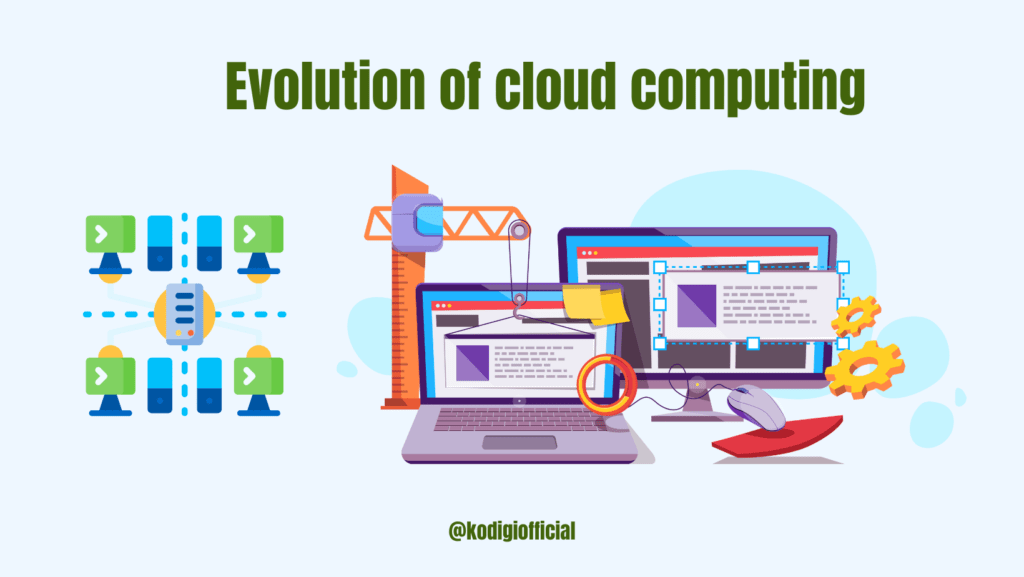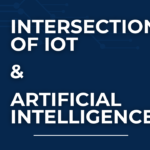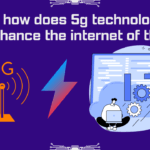Cloud computing has undergone a significant evolution over the past few decades. It is possible to divide its development into three fundamental phases. The first phase began with the introduction of utilities and grid computers in the early 1960s. And it lasted until the pre-internet bubble era. The pioneer of cloud computing was Joseph Carl Robnett Licklider. The second stage began in the late 1990s with the introduction of Application Service Providers (ASPs). It offered corporate services and applications online. The most recent advancement in cloud computing is a result of Web 2.0 technology. It supports web applications that promote user-centered design, interoperability, and participatory information exchange, among other things.
The rise in processing power has been one of the critical factors in the development of cloud computing. Processing huge data collections now takes one-tenth of the time it used to take. It would have taken in the past because of the development of faster computers and more effective algorithms. It was previously challenging to do sophisticated computations in real-time, but this boost in processing capability made it possible.
What is Cloud Computing
It is also referred to as “the cloud,” is the delivery of computing services over the internet, which includes servers, storage, databases, software, and applications. With the utilization of the cloud, anyone can access and utilize computer resources whenever they need to. Via a service provider as opposed to purchasing and maintaining local physical computing hardware. Adaptable, scalable, and cost-effective cloud computing systems can satisfy several technological requirements. It enables organizations and individuals to concentrate on their core activities as opposed to managing IT infrastructure.
Early beginnings: The concept of resource sharing
The idea of resource sharing served as the impetus for the creation of cloud computing. Resources like processing power, storage, and software were expensive and challenging to access in the early days of computing. Researchers and companies created the concept of resource sharing, which allowed numerous people to share access to computing resources, to make the most of these resources.
The concept of cloud computing as we know it now originated in the 1950s. It was a time when businesses and schools began to have access to massive mainframe computers. They placed huge mainframe hardware in a “server room.” Since the room would generally only be able to hold a single mainframe. Time-sharing ideas gained traction in the 1960s thanks to Remote Job Entry. At the start of the 1970s, full-time sharing systems were accessible as a result of this increase.
Compaq first used the term “cloud computing” in 1996. Grid computing, a form of computing that predates cloud computing, gained popularity. Emory University Professor Ramnath Chellappa discussed the cloud in a 1997 article.
The emergence of utility computing and grid computing
A significant turning point in the development of cloud computing was the introduction of utility computing and grid computing.
Utility Computing
Similar to how people pay for utilities like electricity and water, utility computing, also referred to as “metered services,”. It allowed customers to pay for computing resources based on their actual usage. Compared to previous computing models, where organizations had to spend money on and maintain their computing infrastructure. This paradigm provided significant cost savings and flexibility.
Grid Computing
On the other hand, grid computing allowed numerous businesses to share computing resources through a network. Building a fictitious supercomputer that could manage intricate calculations and data analysis. This paradigm made it easier and more affordable for academics to acquire and examine massive data collections.
Grid and utility computing worked together to create the foundation for cloud technology. The cloud computing paradigm offers adaptable, on-demand access to computer resources through the internet. The founding concepts of the cloud are based on paying for computing resources according to usage and sharing resources over a network.
Data centers and the rise of distributed systems
The important drivers in the development of cloud computing as the demand for computing resources kept increasing.
Enormous complexes known as data centers house servers, storage units, and networking hardware. They are designed to provide a secure, reliable, and efficient environment for computing infrastructure. Businesses and organizations needed more durable and scalable computing infrastructure. The tremendous rise in the volume of data being generated and processed led to the need for better data management. An affordable and effective solution to address these needs was supplied by data centers.
Advances in networking technology also made it possible to create distributed systems. Which let several devices and computer resources function as one system. By dividing big data sets and complex computations into smaller jobs and distributing them among various computer resources. Distributed systems provided a solution to handle them.
The union of data centers and distributed systems facilitated the growth of cloud technology. Cloud computing provided for better scalability, flexibility, and efficiency than previous computing models. Since it could store and analyze enormous volumes of data across numerous locations.
The impact of web 2.0 on cloud computing
Web 2.0 significantly influenced the development of cloud technology, as it describes the shift of the internet from static web pages to dynamic and interactive web applications. This era ushered in user-generated content, social networking, and collaboration, which required extensive computing and storage resources.
Web 2.0 ushered in a new era of user-generated content, social networking, and collaboration, needing enormous computing and storage resources. Companies were able to obtain the computer resources they required on demand. As a result of the cost-effective and scalable solution provided by cloud computing.
It greatly increased the capacity to develop new web applications and services. Cloud computing benefited startups and small businesses in particular. It allowed them to access the same amount of processing and storage as larger enterprises without having to make costly infrastructure investments.
With the continued popularity of web-based applications and services, it has emerged as the preferred paradigm for providing these services. It is currently used to power many popular web applications, including social media sites, email services, and online storage.
Mainframe computing and the evolution of central servers
Mainframe computing and the creation of centralized servers greatly influenced the development of cloud computing.
Large, centralized mainframe computers were originally developed in the 1950s and were used to carry out crucial corporate operations like data processing, transaction processing, and financial modeling. Only large enterprises and government organizations could afford to use these computers due to their high cost of acquisition and maintenance.
As computing technology developed, central servers became a more affordable and effective mainframe computing substitute. Similar tasks can be carried out using central servers, which are smaller and less expensive than mainframe computers. They can also be readily scaled up or down to match changing company needs.
A client-server design, in which several users can access resources from a central server across a network, was also made possible by central servers. This architecture made possible the creation of distributed systems, which are crucial to cloud computing. It also offered a mechanism to share computer resources.
The cloud computing approach accesses computing resources via the internet rather than a local network. It has subsequently replaced the central server model. A vital part of contemporary IT infrastructure, it offers businesses and organizations of all sizes a flexible and affordable option to access computing resources on demand.
Cloud computing today: Resource sharing and scalability
With resource sharing and scalability as its two main selling points, cloud computing has developed into an essential component of contemporary IT architecture.
By the use of the internet, cloud computing enables access to computing resources including storage, processing power, and software programs. Users can simply scale up or down to accommodate their changing computing requirements, only paying for the resources they utilize.
A crucial component of cloud computing is resource sharing. Cloud providers can achieve economies of scale by pooling computer resources among numerous customers, making it more affordable for businesses and organizations to access the resources they require.
The advantages of cloud computing go beyond scalability and resource sharing and include improved agility, mobility, and security. Businesses can swiftly roll out new apps and services thanks to cloud computing, which enables them to react to shifting market conditions more quickly.
Cloud computing also enables increased mobility as users can access resources from any location with an internet connection. Finally, cloud providers frequently use strong security measures, which can assist prevent data breaches and cyberattacks.
In general, it has developed into a crucial part of contemporary IT infrastructure, giving businesses and organizations secure, scalable, and affordable access to the computer resources they require.
Future developments in cloud computing: Artificial intelligence and the Internet of Things
Artificial intelligence (AI) and the Internet of Things (IoT) are two emerging technologies that will have a significant impact on the future of cloud computing (IoT).
Because it can be used to automate complicated operations and make predictions based on data analysis, artificial intelligence (AI) has the potential to transform cloud computing. It can become even more effective, affordable, and secure with the aid of AI. Using AI-powered technologies to detect security risks and vulnerabilities in real time can help reduce the risk of data breaches and cyber-attacks.
Another technology that will propel the development of cloud computing is the Internet of Things. It might be difficult for traditional computing systems to process and evaluate the large amounts of data that IoT devices produce in real-time. It offers a practical and scalable solution to the challenge of analyzing and processing data at scale from IoT devices, as they can be connected to cloud-based data centers.
New cloud computing applications and services, such as AI-powered IoT devices that can learn from and adapt to user behavior or cloud-based analytics tools that can be used to derive insights from IoT data, will be made possible by the convergence of AI and IoT. Businesses and organizations will be able to better understand their customers and manage their operations thanks to these innovations, which will ultimately result in higher productivity and profitability.
Overall, it has a promising future, with the ability to open up new doors and spur innovation in a variety of different industries. We may anticipate even more fascinating advancements in the field of cloud computing as AI and IoT evolve further.
What are some examples of cloud computing?
There are many examples of cloud computing. Here are some of them:
- Dropbox
- Gmail
- Banking and Financial Services
- Health Care
- Education
- Government
- Big data Analytics
- Communication
- Business Process
Challenges and risks in cloud computing: Security and data privacy
While cloud computing has many advantages, it also comes with a lot of risks and concerns, especially in terms of security and data privacy.
Security is one of the main problems. Although it is the responsibility of cloud providers to safeguard their infrastructure and preserve client data. Even the most stringent security measures can fall victim to hacker attacks and data breaches. If an assault does take place, it may jeopardize critical information, resulting in monetary loss, reputational harm, and legal liability.
Data privacy in cloud computing presents another difficulty. Businesses and organizations that store their data in the cloud are giving cloud service providers access to sensitive data about their clients and business processes. There is always a chance that unauthorized third parties could access, alter, or steal this data.
Compliance with laws and standards, vendor lock-in, and the complexity of managing cloud-based infrastructure are some other difficulties with it.
Businesses and organizations must be vigilant about cloud security and data privacy if they want to reduce these dangers. This entails putting in place stringent authentication, encryption, and control procedures, as well as routine monitoring and auditing of cloud-based infrastructure for security flaws.
Companies should thoroughly vet cloud providers before signing contracts. They should opt for ones that offer strong security and data privacy safeguards and that adhere to pertinent laws and standards. Also, it is important to implement proper security measures to protect sensitive data stored in the cloud.
Ultimately, despite the risks and challenges associated with cloud computing, they can be effectively managed with the right systems, processes, and partnerships. Businesses and organizations can effectively use the advantages of cloud computing to accomplish their objectives and spur growth with careful planning and management.
Conclusion: The continued evolution and importance of cloud computing.
Since its inception as a concept of resource sharing, it has advanced significantly. In many different industries today, it is a fundamental technology that supports digital transformation.
Cloud computing has changed significantly throughout the years. It has evolved from utility computing and grid computing to the rise of distributed systems and data centers. It highlights the impact of Web 2.0 and the future potential of AI and IoT in the evolution of cloud computing.
Businesses and organizations are still embracing cloud technology at a rapid rate despite the difficulties and risks involved, such as security and data privacy issues. Scalability, efficiency, and agility are a few advantages of cloud computing that greatly transcend any potential hazards.
Looking ahead, it is expected to become even more crucial as companies and organizations try to make the most of cutting-edge technology like AI and IoT. For this, it will be necessary to maintain innovation in cloud infrastructure and to make significant investments in data privacy and security.
Ultimately, the development and significance of cloud computing highlight how important technology is in creating the society we live in today. As time goes on, we may anticipate even more exciting advances in the field of cloud computing, which will open up new possibilities and spur innovation in a variety of sectors.




